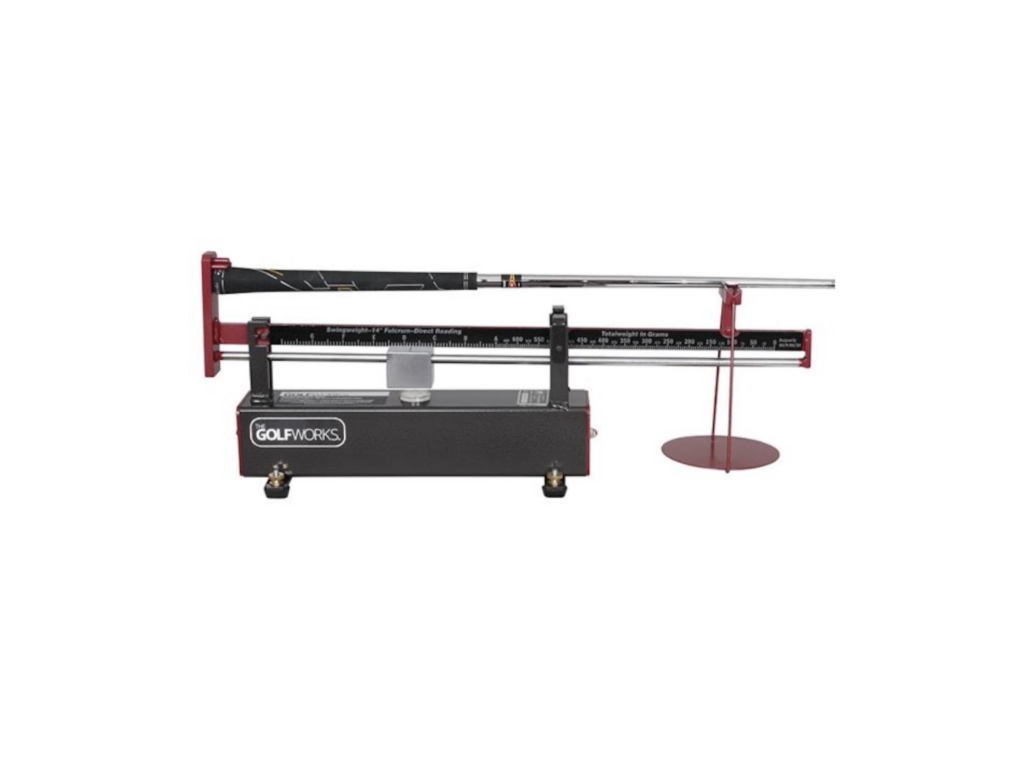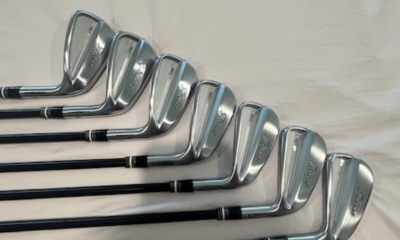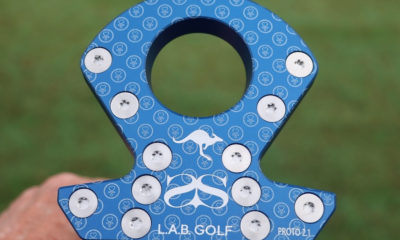Opinion & Analysis
The Wedge Guy: A discussion of swingweight (Part 1: History)

For the twenty-five plus years, I’ve been in the equipment business, one of the most commonly-asked-about subjects is that of swingweight. It mostly comes up when a golfer is requesting over-length clubs or is contemplating changing to graphite shafts. So, I’m going to direct a discussion of this topic. Please chime in to let me know your thoughts and input.
The concept of swingweight was developed by custom clubmaker Kenneth Smith about 60 years ago. He was trying to figure out how to “match” clubs, and settled on balance point as a way to do so. His swingweight scale had a “hook” to hold the grip end of the club, and a fulcrum 14 inches from the butt. He created an arbitrary scale of measure that consisted of letters A-F, each letter divided into ten segments, i.e. D1, D2, D3, etc. When he measured the clubs of the day, he found most of them to be in the D2 range, so that became recognized as the “standard” for men’s woods and irons.
The golf club industry quickly adopted this method of “matching” clubs…well, because they had no other way! Because the longer the shaft, the heavier the head feels, clubheads increase in weight as the shaft gets shorter, so that the swingweight will stay the same. The theory then, and now, is that if the swingweight is the same, the clubs will feel essentially the same in the golfer’s hands.
But let’s look at what has happened since Kenneth Smith invented the swingweight scale.
- Shafts have gotten longer by at least an inch. In the 1940s, a “standard” driver was only 42-43” long – now most are 45” if not more.
- Shafts have gotten much lighter. Those old steel shafts weighed 150 grams or more, compared to modern graphite driver shafts in the 55-75 gram range.
- Golfers have gotten stronger while clubs have gotten much lighter overall, but swingweights have always adhered to that D2 “standard.”
You must understand two very important factors about swingweight.
First, a “point” of swingweight–such as D2 to D3–is NOT a unit of measure like an ounce or gram. It takes much less weight to shift a driver one point, for example, than it does a wedge, because the shaft length is such an influence on this measure. Generally, the weight of a single dollar bill is a swingweight point on a driver—not much, huh?
And secondly, the overall weight of the club is at least as important as swingweight. Jack Nicklaus was noted for playing a driver in his prime that was 13.25 oz in overall weight–very heavy even for that time (most are about 10.5 oz now!), while his swingweight was only C9, considered very light. S
Swingweight by itself is a rather worthless piece of information!
So, that should get this discussion going. I’ll give you a few days to toss out your questions and comments on this subject, and then I’ll begin to address my own theories on swingweight for YOUR clubs.
Sound off, readers!
- LIKE90
- LEGIT19
- WOW5
- LOL0
- IDHT1
- FLOP3
- OB1
- SHANK5
19th Hole
Vincenzi’s LIV Golf Singapore betting preview: Course specialist ready to thrive once again

After another strong showing in Australia, LIV Golf will head to Sentosa Golf Club in Singapore looking to build off of what was undoubtedly their best event to date.
Sentosa Golf Club sits on the southern tip of Singapore and is one of the most beautiful courses in the world. The course is more than just incredible scenically; it was also rated 55th in Golf Digest’s top-100 courses in 2022-2023 and has been consistently regarded as one of the best courses in Asia. Prior to being part of the LIV rotation, the course hosted the Singapore Open every year since 2005.
Sentosa Golf Club is a par 71 measuring 7,406 yards. The course will require precise ball striking and some length off the tee. It’s possible to go low due to the pristine conditions, but there are also plenty of hazards and difficult spots on the course that can bring double bogey into play in a hurry. The Bermudagrass greens are perfectly manicured, and the course has spent millions on the sub-air system to keep the greens rolling fast. I spoke to Asian Tour player, Travis Smyth, who described the greens as “the best [he’s] ever played.”
Davis Love III, who competed in a Singapore Open in 2019, also gushed over the condition of the golf course.
“I love the greens. They are fabulous,” the 21-time PGA Tour winner said.
Love III also spoke about other aspects of the golf course.
“The greens are great; the fairways are perfect. It is a wonderful course, and it’s tricky off the tee.”
“It’s a long golf course, and you get some long iron shots. It takes somebody hitting it great to hit every green even though they are big.”
As Love III said, the course can be difficult off the tee due to the length of the course and the trouble looming around every corner. It will take a terrific ball striking week to win at Sentosa Golf Club.
In his pre-tournament press conference last season, Phil Mickelson echoed many of the same sentiments.
“To play Sentosa effectively, you’re going to have a lot of shots from 160 to 210, a lot of full 6-, 7-, 8-iron shots, and you need to hit those really well and you need to drive the ball well.”
Golfers who excel from tee to green and can dial in their longer irons will have a massive advantage this week.
Stat Leaders at LIV Golf Adelaide:
Fairways Hit
1.) Louis Oosthuizen
2.) Anirban Lahiri
3.) Jon Rahm
4.) Brendan Steele
5.) Cameron Tringale
Greens in Regulation
1.) Brooks Koepka
2.) Brendan Steele
3.) Dean Burmester
4.) Cameron Tringale
5.) Anirban Lahiri
Birdies Made
1.) Brendan Steele
2.) Dean Burmester
3.) Thomas Pieters
4.) Patrick Reed
5.) Carlos Ortiz
LIV Golf Individual Standings:
1.) Joaquin Niemann
2.) Jon Rahm
3.) Dean Burmester
4.) Louis Oosthuizen
5.) Abraham Ancer
LIV Golf Team Standings:
1.) Crushers
2.) Legion XIII
3.) Torque
4.) Stinger GC
5.) Ripper GC
LIV Golf Singapore Picks
Sergio Garcia +3000 (DraftKings)
Sergio Garcia is no stranger to Sentosa Golf Club. The Spaniard won the Singapore Open in 2018 by five strokes and lost in a playoff at LIV Singapore last year to scorching hot Talor Gooch. Looking at the course setup, it’s no surprise that a player like Sergio has played incredible golf here. He’s long off the tee and is one of the better long iron players in the world when he’s in form. Garcia is also statistically a much better putter on Bermudagrass than he is on other putting surfaces. He’s putt extremely well on Sentosa’s incredibly pure green complexes.
This season, Garcia has two runner-up finishes, both of them being playoff losses. Both El Camaleon and Doral are courses he’s had success at in his career. The Spaniard is a player who plays well at his tracks, and Sentosa is one of them. I believe Sergio will get himself in the mix this week. Hopefully the third time is a charm in Singapore.
Paul Casey +3300 (FanDuel)
Paul Casey is in the midst of one of his best seasons in the five years or so. The results recently have been up and down, but he’s shown that when he’s on a golf course that suits his game, he’s amongst the contenders.
This season, Casey has finishes of T5 (LIV Las Vegas), T2 (LIV Hong Kong), and a 6th at the Singapore Classic on the DP World Tour. At his best, the Englishman is one of the best long iron players in the world, which makes him a strong fit for Sentosa. Despite being in poor form last season, he was able to fire a Sunday 63, which shows he can low here at the course.
It’s been three years since Casey has won a tournament (Omega Dubai Desert Classic in 2021), but he’s been one of the top players on LIV this season and I think he can get it done at some point this season.
Mito Pereira +5000 (Bet365)
Since Mito Pereira’s unfortunate demise at the 2022 PGA Championship, he’s been extremely inconsistent. However, over the past few months, the Chilean has played well on the International Series as well as his most recent LIV start. Mito finished 8th at LIV Adelaide, which was his best LIV finish this season.
Last year, Pereira finished 5th at LIV Singapore, shooting fantastic rounds of 67-66-66. It makes sense why Mito would like Sentosa, as preeminent ball strikers tend to rise to the challenge of the golf course. He’s a great long iron player who is long and straight off the tee.
Mito has some experience playing in Asia and is one of the most talented players on LIV who’s yet to get in the winner’s circle. I have questions about whether or not he can come through once in contention, but if he gets there, I’m happy to roll the dice.
Andy Ogletree +15000 (DraftKings)
Andy Ogletree is a player I expected to have a strong 2024 but struggled early in his first full season on LIV. After failing to crack the top-25 in any LIV event this year, the former U.S. Amateur champion finally figured things out, finished in a tie for 3rd at LIV Adelaide.
Ogletree should be incredible comfortable playing in Singapore. He won the International Series Qatar last year and finished T3 at the International Series Singapore. The 26-year-old was arguably the best player on the Asian Tour in 2023 and has been fantastic in the continent over the past 18 months.
If Ogletree has indeed found form, he looks to be an amazing value at triple-digit odds.
- LIKE1
- LEGIT0
- WOW0
- LOL0
- IDHT0
- FLOP0
- OB0
- SHANK0
Opinion & Analysis
Ryan: Lessons from the worst golf instructor in America

In Tampa, there is a golf course that boasts carts that do not work, a water range, and a group of players none of which have any chance to break 80. The course is overseen by a staff of crusty men who have succeeded at nothing in life but ending up at the worst-run course in America. However, this place is no failure. With several other local courses going out of business — and boasting outstanding greens — the place is booked full.
While I came for the great greens, I stayed to watch our resident instructor; a poor-tempered, method teacher who caters to the hopeless. At first, it was simply hilarious. However, after months of listening and watching, something clicked. I realized I had a front-row seat to the worst golf instructor in America.
Here are some of my key takeaways.
Method Teacher
It is widely accepted that there are three types of golf instructors: system teachers, non-system teachers, and method teachers. Method teachers prescribe the same antidote for each student based on a preamble which teachers can learn in a couple day certification.
Method teaching allows anyone to be certified. This process caters to the lowest caliber instructor, creating the illusion of competency. This empowers these underqualified instructors with the moniker of “certified” to prey on the innocent and uninformed.
The Cult of Stack and Jilt
The Stack and Tilt website proudly boasts, “A golfer swings his hands inward in the backswing as opposed to straight back to 1) create power, similar to a field goal kicker moving his leg in an arc and 2) to promote a swing that is in-to-out, which produces a draw (and eliminates a slice).”
Now, let me tell you something, there is this law of the universe which says “energy can either be created or destroyed,” so either these guys are defying physics or they have no idea what they are taking about. Further, the idea that the first move of the backswing determines impact is conjecture with a splash of utter fantasy.
These are the pontifications of a method — a set of prescriptions applied to everyone with the hope of some success through the placebo effect. It is one thing for a naive student to believe, for a golf instructor to drink and then dispel this Kool-Aid is malpractice.
Fooled by Randomness
In flipping a coin, or even a March Madness bet, there is a 50-50 chance of success. In golf, especially for new players, results are asymmetric. Simply put: Anything can happen. The problem is that when bad instructors work with high handicappers, each and every shot gets its own diagnosis and prescription. Soon the student is overwhelmed.
Now here’s the sinister thing: The overwhelming information is by design. In this case, the coach is not trying to make you better, they are trying to make you reliant on them for information. A quasi Stockholm syndrome of codependency.
Practice
One of the most important scientists of the 20th century was Ivan Pavlov. As you might recall, he found that animals, including humans, could be conditioned into biological responses. In golf, the idea of practice has made millions of hackers salivate that they are one lesson or practice session from “the secret.”
Sunk Cost
The idea for the worst golf instructor is to create control and dependency so that clients ignore the sunk cost of not getting better. Instead, they are held hostage by the idea that they are one lesson or tip away from unlocking their potential.
Cliches
Cliches have the effect of terminating thoughts. However, they are the weapon of choice for this instructor. Add some hyperbole and students actually get no information. As a result, these players couldn’t play golf. When they did, they had no real scheme. With no idea what they are doing, they would descend into a spiral of no idea what to do, bad results, lower confidence, and running back to the lesson tee from more cliches.
The fact is that poor instruction is about conditioning players to become reliant members of your cult. To take away autonomy. To use practice as a form of control. To sell more golf lessons not by making people better but through the guise that without the teacher, the student can never reach their full potential. All under the umbrella of being “certified” (in a 2-day course!) and a melee of cliches.
This of course is not just happening at my muni but is a systemic problem around the country and around the world, the consequences of which are giving people a great reason to stop playing golf. But hey, at least it’s selling a lot of golf balls…
- LIKE1
- LEGIT0
- WOW0
- LOL0
- IDHT0
- FLOP0
- OB0
- SHANK0
19th Hole
Vincenzi’s 2024 Zurich Classic of New Orleans betting preview

The PGA TOUR heads to New Orleans to play the 2023 Zurich Classic of New Orleans. In a welcome change from the usual stroke play, the Zurich Classic is a team event. On Thursday and Saturday, the teams play best ball, and on Friday and Sunday the teams play alternate shot.
TPC Louisiana is a par 72 that measures 7,425 yards. The course features some short par 4s and plenty of water and bunkers, which makes for a lot of exciting risk/reward scenarios for competitors. Pete Dye designed the course in 2004 specifically for the Zurich Classic, although the event didn’t make its debut until 2007 because of Hurricane Katrina.
Coming off of the Masters and a signature event in consecutive weeks, the field this week is a step down, and understandably so. Many of the world’s top players will be using this time to rest after a busy stretch.
However, there are some interesting teams this season with some stars making surprise appearances in the team event. Some notable teams include Patrick Cantlay and Xander Schauffele, Rory McIlroy and Shane Lowry, Collin Morikawa and Kurt Kitayama, Will Zalatoris and Sahith Theegala as well as a few Canadian teams, Nick Taylor and Adam Hadwin and Taylor Pendrith and Corey Conners.
Past Winners at TPC Louisiana
- 2023: Riley/Hardy (-30)
- 2022: Cantlay/Schauffele (-29)
- 2021: Leishman/Smith (-20)
- 2019: Palmer/Rahm (-26)
- 2018: Horschel/Piercy (-22)
- 2017: Blixt/Smith (-27)
2024 Zurich Classic of New Orleans Picks
Tom Hoge/Maverick McNealy +2500 (DraftKings)
Tom Hoge is coming off of a solid T18 finish at the RBC Heritage and finished T13 at last year’s Zurich Classic alongside Harris English.
This season, Hoge is having one of his best years on Tour in terms of Strokes Gained: Approach. In his last 24 rounds, the only player to top him on the category is Scottie Scheffler. Hoge has been solid on Pete Dye designs, ranking 28th in the field over his past 36 rounds.
McNealy is also having a solid season. He’s finished T6 at the Waste Management Phoenix Open and T9 at the PLAYERS Championship. He recently started working with world renowned swing coach, Butch Harmon, and its seemingly paid dividends in 2024.
Keith Mitchell/Joel Dahmen +4000 (DraftKings)
Keith Mitchell is having a fantastic season, finishing in the top-20 of five of his past seven starts on Tour. Most recently, Mitchell finished T14 at the Valero Texas Open and gained a whopping 6.0 strokes off the tee. He finished 6th at last year’s Zurich Classic.
Joel Dahmen is having a resurgent year and has been dialed in with his irons. He also has a T11 finish at the PLAYERS Championship at TPC Sawgrass which is another Pete Dye track. With Mitchell’s length and Dahmen’s ability to put it close with his short irons, the Mitchell/Dahmen combination will be dangerous this week.
Taylor Moore/Matt NeSmith +6500 (DraftKings)
Taylor Moore has quickly developed into one of the more consistent players on Tour. He’s finished in the top-20 in three of his past four starts, including a very impressive showing at The Masters, finishing T20. He’s also finished T4 at this event in consecutive seasons alongside Matt NeSmith.
NeSmith isn’t having a great 2024, but has seemed to elevate his game in this format. He finished T26 at Pete Dye’s TPC Sawgrass, which gives the 30-year-old something to build off of. NeSmith is also a great putter on Bermudagrass, which could help elevate Moore’s ball striking prowess.
- LIKE8
- LEGIT3
- WOW1
- LOL1
- IDHT0
- FLOP3
- OB1
- SHANK2
-

 19th Hole3 weeks ago
19th Hole3 weeks agoDave Portnoy places monstrous outright bet for the 2024 Masters
-

 19th Hole1 week ago
19th Hole1 week agoJustin Thomas on the equipment choice of Scottie Scheffler that he thinks is ‘weird’
-

 19th Hole1 week ago
19th Hole1 week ago‘Absolutely crazy’ – Major champ lays into Patrick Cantlay over his decision on final hole of RBC Heritage
-

 19th Hole2 weeks ago
19th Hole2 weeks agoTwo star names reportedly blanked Jon Rahm all week at the Masters
-

 19th Hole2 weeks ago
19th Hole2 weeks agoReport: LIV Golf identifies latest star name they hope to sign to breakaway tour
-

 19th Hole2 weeks ago
19th Hole2 weeks agoNeal Shipley presser ends in awkward fashion after reporter claims Tiger handed him note on 8th fairway
-

 19th Hole2 weeks ago
19th Hole2 weeks agoBrandel Chamblee has ‘no doubt’ who started the McIlroy/LIV rumor and why
-

 Equipment3 weeks ago
Equipment3 weeks agoWhat we know about Bryson DeChambeau’s 3D-printed Avoda irons

























Stuart
Oct 29, 2023 at 5:24 am
Based on what I’ve read – Kenneth Smith did not design the swing weight scale. The scale was originally designed by R.W. Adams, who got the patent in 1934. As I understand it, Kennith Smith bought the rights to use Adam’s invention in 1945 and started producing them with both 14″ and 12″ fulcrum points.
Also, they certainly did have ways to match the clubs before the scale – but the calculations were tedious. Adam’s wanted to find an easier way.
Bob Pegram
Jul 13, 2020 at 5:00 am
The reason Nicklaus’ clubs were heavy, but with a light swing weight is that they were backweighted which simultaneously makes the clubs heavier, but reduces the swing weight.
My clubs are MOI weighted. The irons are 1-1/2 inches overlength and have graphite X shafts to keep the swing weight down. Also, 2 inches longer length is a whole flex difference. In other words they flex only a little stiffer than S flex. The cheating way to do MOI matching is to make each higher numbered club 0.65 swing weight higher for each 1/2 inch shorter it is (or 1.3 swing weights heaver per 1 inch shorter). They are easier to hit consistently with MOI weighting.
Bob Pegram
Jul 13, 2020 at 5:04 am
Forgot to mention: All of my wedges (PW, 54, 60) are the same length (37 inches), but each one gets heaver by approximately 0.65 swing weight. The Lob is a little heavier than that. All have the same graphite shafts as the other irons.
Grey
Jul 10, 2020 at 1:01 am
I’ve just received my custom built wedges. TM MG2 52, 56, 60 all .5” over standard. The swing weights are coming in at D10, E0, E1. I notice pretty small changes in the feel of equipment. I feel like I’m swinging a garden hoe. Shafts are Nippon Modus 120 S. Is there something about the balance or kickpoint making the swingweight so high? I’ve always thought .5” adds 3 SW points.
joro
Jul 10, 2020 at 11:56 am
The sad part is that the big club companies do not care. They take a head and shaft and put it together with a grip and call it a custom. I bought a couple of Vokey Wedges and specified what I wanted. The Two Wedges came and they were two different models and not even close to what I had ordered. I had to rebuild them myself to get them right.
BD
Jul 8, 2020 at 3:30 pm
I laugh when people are so concerned about swingweight. I can make a telephone pole D2 if I wanted to.
Regardt van Rooyen
Jul 8, 2020 at 2:28 pm
100% agree with William Terry. My clubs have been MOI’d for over 10 years now. It’s all about feel weight and not swing weight. Like you’ve explained, you can have a VERY heavy golf club but have a light swingweight.
A simple way to MOI your irons without a Swing Weight machine is to build your 7i light and go through a specific swing weight test. Keep adding weight until you find your desired feel. Measure that 7i, let’s say it comes out at D2 then follow the next clubs up and down with a half a swing weight, for example:
3i – D0
4i – D0.5
5i – D1
6i – D1.5
7i – D2
8i – D2.5
9i – D3
PW – D3.5
This will get you VERY close to the same MOI (feel kr how much force it takes to move your club) in your irons
Regardt van Rooyen
Jul 8, 2020 at 2:31 pm
Correction, “to MOI your irons without a MOI Machine”
William Terry
Jul 8, 2020 at 12:02 pm
Do you think people would be better off matching MOI instead of swing weight?
Hurley
Jul 8, 2020 at 4:59 pm
Yes – to a degree – but the important thing is to get a baseline. And that takes trial and error to find that starting point. I’ve noticed for me and many others, there’s definitely a small range where things feel good. Way above or below this, and it’s no good. So you have to MOI a test club then break out the lead tape and get to work.
Other thing to note is MOI matching really shouldn’t be for an entire bag – same as SW. You should generally break it down to woods, irons, and wedges – and most will prefer woods and wedges higher than irons. Also, here’s another consideration, courtesy of @howard_jones – even though SW isn’t a unit of measure, it can still come in handy. Let’s say there’s a test club built – a 9i – and we get an MOI measurement. Now we take that same 9i and take the SW value on it. Now you have baseline SW and MOI. Think of these as the two “extremes” and the rest of the set may fall somewhere in between. If you SW match a 4i, the MOI will be very different than the MOI matched value. The individual can hit both and see how they each feel, or do the same thing as the test club – break out the lead tape and build it up until it feels right. At the end, you’ll find some people may perform better with MOI match (progressive SW), some with SW match (progressive MOI), and some will fall somewhere in between. It’s crucial to get the measurements of a short and long test club and then draw the slope to find out where the rest of them may fall.
The advantage of MOI over SW is 1) it’s a measurement and 2) it’s transferable across clubs. SW is not – it’s only valid when the components are all the same (heads, shafts, ferrules, grips, etc). So if you get a new set of irons, you CAN say, “my MOI is 2800” and have them built to that and unless head or shaft weights are WAY different, they’ll feel the same. What you CAN’T do is say “I want them at D3” and expect them to be the same. For this reason alone, MOI is way more valuable.
All in all, in club building there is no shortcut. I think length and total weight are most important. It’s a combination of art and science to get it right.
drkviol801
Jul 9, 2020 at 8:10 am
You guys have no idea what you’re talking about. If you don’t play for a living your opinion is meaningless.
51TJesx
Jul 9, 2020 at 1:50 pm
Dumbest comment on here in awhile. Newsflash – pros get paid to play and don’t work on their clubs. That’s why they have tour vans and those guys are paid to build clubs, not paid to play.
Go try to refute a single thing that was stated – you can’t.
You likely don’t get paid much for anything.
joro
Jul 10, 2020 at 10:45 am
Let me tell you that the “ones that play for a living” aren’t that aware, and that is why they have a club maker in the Tour Dept. to do it for them. I made a lot of clubs for Tour Pros and most had no clue, it mot have felt right but they did not know how to correct. Leave it to the pro club makers who know what to do.
Like one poster said, yoo can lighten a telephone pole to the B range or make a Graphite shaft into the F range by where you put the weight, that is simple and also applies to the completed club… There is a danger to all that though, one is length if you cut or extend the shaft, and the other can by overall weight. So I say, if there is a problem look up a competent club maker and not a person who plays for a living. They know their specs and so does the guy that makes their clubs.
Ted Noel
Jul 11, 2020 at 5:11 pm
I agree that MOI is a great improvement over SW. I build clubs (hobbyist) and if I MOI match clubs, they will work well as a set. Note that MOI integrates weight distribution, elements of flex, and more. It’s a dynamic measurement that approximates how clubs feel in the hand.
Of key importance, MOI measured from the butt cap is not what you feel MOI measured from 3 1/2- 4 1/2 inches down from the butt cap is much better, and if done properly, works from Drivers through wedges. Unfortunately, the only available MOI machine is set up to measure from the butt cap only, so masking tape kluges come into play.
Perfect MOI matching is one reason that equal length irons play better for many people. (A single swing is the other, but that’s a different discussion.)